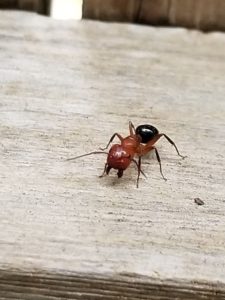Carpenter Ants Capitalizing on Freeze Damage
With the freeze we had earlier this year, many people lost trees or branches of trees. Many people have already cleaned up their yard but others are still waiting for help from arborists to cut down dead trees or prune damaged limbs. If you, or your neighbor, is one of the people who choose to leave things in place, you may now be dealing with carpenter ants.

Identifying Carpenter Ants
Carpenter ants are large ants varying in color from all black to reddish to yellowish or a combination of these colors. They have one node, no stinger, and a circle of hairs at the tip of their abdomen (which you’ll need a good hand lens or microscope to see). They also have a smoothly humped thorax when you look at them in profile.
Carpenter ants typically nest outdoors in dead wood (tree stumps, dead limbs, fences, firewood, etc.). Sometimes the ants are in wood siding, beams, joists, fascia boards, or trim on structures. Damage is usually limited since carpenter ants tunnel and nest within wood; they do not eat wood. However, wood can become weakened by carpenter ant excavation.
Damage is Different than Termites
Galleries in carpenter ant nests are excavated following the grain of the wood and have clean, smooth walls which allows you tell the difference between carpenter ant damage and termite damage. Nest locations can sometimes be discovered by searching for piles of sawdust-looking material under kick-out or exit holes; this is the carpenter ant frass or waste material. Frass is made up of coarse pieces of wood and may also contain soil or sand, uneaten insects, as well as dead ants from the colony.
Carpenter ants have mating flights, or swarms, to begin new colonies. After mating, males die while females drop to the ground, chew off their wings, and locate a suitable nesting site. Females then lay 15-20 eggs which develop into worker ants in about two months. The queen cares for the first batch of brood (eggs, larvae, pupae) and feeds them secretions from her body. Once the first batch of brood has emerged as adult workers, they take over care of the colony by expanding the nest, providing food for the queen, and caring for new brood.
Not a Problem Unless House is Infested
When carpenter ants are found outdoors, they do not really cause much of an issue, but they are able to enter homes from tree branches or utility lines touching the home, through cracks and crevices around windows and doors, cracks in foundation walls, ventilation openings, or heating and air conditioning ducts.
Avoid Problems With These Tips
Here are some tips for a carpenter ant infestation:
- Remove dead trees, limbs, and tree stumps from the landscape. You can remove the (possible) nesting sites and get rid of the ants without using pesticides.
- Prune trees and shrubs that touch or overhang the home. Carpenter ants can use these areas as a bridge to enter homes.
- Replace wood that has water, fungal, or termite damage. Carpenter ants prefer wood that has damage from previous issues.
- Remove wood debris and firewood that is near the home. Carpenter ants may nest in firewood and when it is stacked right next to the home, it allows ants to enter easily.
For more information or help with identification, contact Wizzie Brown, Texas AgriLife Extension Service Program Specialist at 512.854.9600.
About Wizzie

Wizzie Brown
County Extension Program Specialist – Integrated Pest Management
Email:EBrown@ag.tamu.edu
Wizzie has been with Texas A&M AgriLife Extension Service since 2002 and has been playing with insects since she was a toddler. She is an Extension Program Specialist with the Integrated Pest Management (IPM) program. Wizzie holds a B.S. in entomology from The Ohio State University and a M.S. in entomology from Texas A&M University. The integrated pest management program provides identification, biological and management information to whomever needs help. Wizzie’s research focuses on imported fire ants, including community wide fire ant management. Wizzie also is happy to provide programs to area groups on a variety of arthropod-related topics. You can find insect and other arthropod information on Wizzie’s blog.
